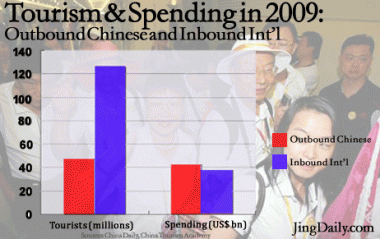Mainland Tourist Spending Abroad Outspent International Tourist Spending In China For The First Time#

Chinese Media is reporting this week that outbound tourists from mainland China spent some $42 billion overseas (including Hong Kong, Macau and Taiwan) last year, outspending inbound international tourists for the first time. Though articles do point out that the majority of first-time outbound tourists from the mainland went to nearby Hong Kong (18%) and Macau (16%) -- two very accessible destinations for Chinese tourists, who typically travel there for quick weekend jaunts or shopping sprees -- more of them are heading to more distant locales, staying longer, and spending more. As a recent AdAge article noted, around 500,000 Chinese tourists traveled to America in 2009, each staying an average of 23 days and spending over $7,000 apiece on average. While the article does not mention whether this figure includes non-mainland tourists, it does echo what we're hearing from places like France, where mainland tourists often spend higher per capita than other tourists on luxury goods and "wine tourism."
However, the important development in Chinese outbound travel isn't led by the super-rich. As a result of a growing middle class, easing travel restrictions and tour group incentives, outbound tourism among mainland Chinese has grown at a double-digit pace, and retailers in Europe and Hong Kong in particular are likely hoping that 2010 brings even more free-spending mainlanders their way. According to the China Tourism Academy, this very well may be the case in the year ahead, as the academy has forecast that 54 million mainland tourists will head overseas in 2010, an increase of 15 percent year-on-year.
As a China Daily article today points out, despite the huge discrepancy between the number of inbound tourists to China and outbound Chinese tourists, Chinese tourists tend to place primary emphasis on shopping, while international tourists in China go there for sightseeing. However, the article does point out that this follows a precedent in previous decades, when foreign tourists in the late 1970s and early 1980s (and, the case can be made, in the pre-WWII years) were comparatively wealthier and spent more per capita than the modern-day backpackers and middle class travelers who now make up the bulk of inbound tourists to China.
"Chinese tourists have a different spending concept from others. They could endure staying at a three-star hotel and eating at a not-so-good restaurant, but would never go back home empty-handed," said Zhang Wei, general manager of the outbound department with the China International Travel Service head office.
Also, since many imported goods are sold on the Chinese mainland at much higher prices, many tourists shop for expensive watches, clothes and cosmetics overseas, she said.
Beijinger Gao Xuenan, on her trip to Europe last month, spent some 13,000 yuan ($1,900) on a Louis Vuitton bag and a purse, and spent another 2,000 yuan on a Burberry scarf.
"The prices of these goods are much higher in Beijing. The scarf, sold at more than 4,000 yuan, is even out of stock in Beijing. I kind of feel I would suffer a loss if I don't buy them in Europe," she said.
As China's middle class grows, and foreign travel becomes more accessible to that huge demographic, the reasoning would follow that Chinese outbound tourists will place more emphasis on experiential tourism and sightseeing, rather than simply treating foreign travel as a long-distance shopping trip.